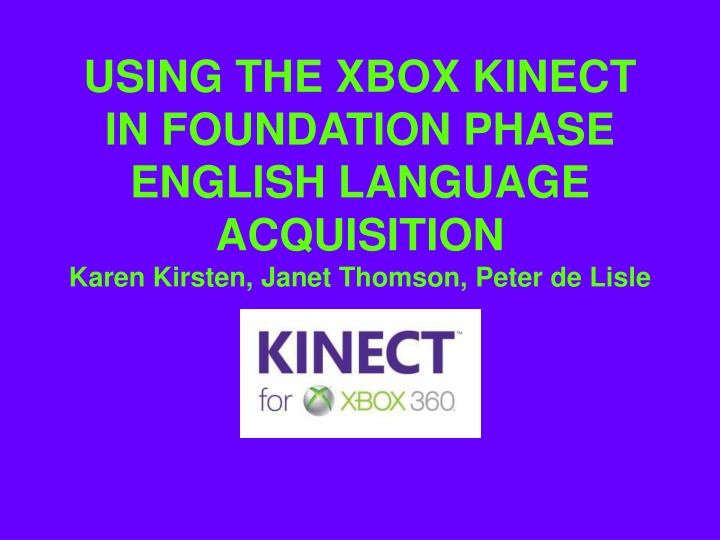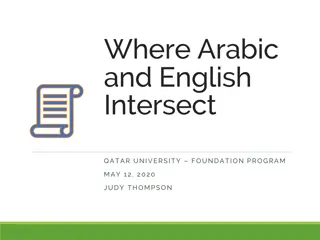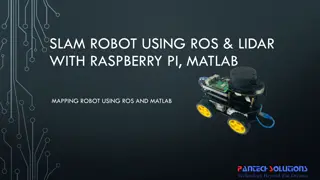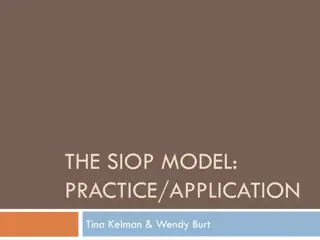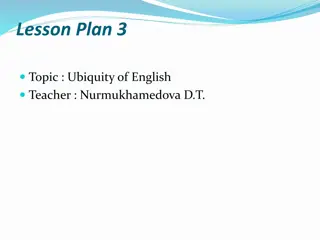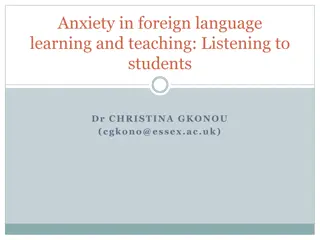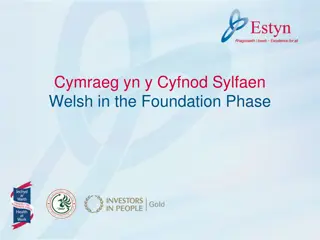Using Xbox Kinect for English Language Acquisition in Foundation Phase
"Explore the integration of Xbox Kinect technology in English language learning at Lakeside Primary Vryheid, focusing on overcoming language barriers and implementing language-supportive pedagogy for effective literacy acquisition in English."
Download Presentation

Please find below an Image/Link to download the presentation.
The content on the website is provided AS IS for your information and personal use only. It may not be sold, licensed, or shared on other websites without obtaining consent from the author.If you encounter any issues during the download, it is possible that the publisher has removed the file from their server.
You are allowed to download the files provided on this website for personal or commercial use, subject to the condition that they are used lawfully. All files are the property of their respective owners.
The content on the website is provided AS IS for your information and personal use only. It may not be sold, licensed, or shared on other websites without obtaining consent from the author.
E N D
Presentation Transcript
USING THE XBOX KINECT IN FOUNDATION PHASE ENGLISH LANGUAGE ACQUISITION Karen Kirsten, Janet Thomson, Peter de Lisle
When, Where, What 1 months after international launch of Kinect Lakeside Primary Vryheid Basic Classroom setup
I: The Problem, & Principles for finding a Solution
English as Language of Learning Learning through English is difficult. family illiteracy low exposure to English gap between learners language ability and the language demands of the curriculum Teachers not geared towards using a language-supportive pedagogy (Clegg, Ogange, & Rodseth, 2003)
Features of Language-supportive Pedagogy Use tasks which provide language support Use teacher-talk to present concepts Vary the form of classroom interaction teacher-centred, group, pairs, individual work Use visuals to support understanding Teach learning strategies for learning in a L2 Encourage learners to use their L1 under specific circumstances (Clegg, Ogange, & Rodseth, 2003)
L2 Literacy in English Literacy programs that provide instructional support of oral language development in English, aligned with high-quality literacy instruction are the most successful. Students instructed in their native language as well as in English perform better. (August, 2006)
Oral Activities talk (in small groups) speak using guidance from visual information gap activities card sorting speak, record and listen guidance from words/phrases guidance from connectors use a speaking frame speak using a model (e.g. sentence pattern) listen and repeat a sound/structure
Pedagogical approach for the Acquisition of Literacy in English The key objective in learning language is communication. Teachers need to focus primarily on Oral proficiency Create an environment which supports and encourages learners to experiment with speaking in English and developing basic literacy skills. In all activities, a language-sensitive approach must be used. Work across the curriculum, not just in English lessons.
Educational Philosophy Learner-centred Exploration and discovery Learners create meaning, teachers facilitate Differentiated various learning styles, not just listening cognitive development thinking, problem solving, fantasy and creativity Active: physically, cognitively and emotionally activities that are fun, challenging relevant to the learners lives in the real world Motivation enthusiasm and involvement activities which are naturally engaging.
Games in Education Computer as Teacher Drill & Kill Computer as Creator of Context An immersive experience Simulates real life Eg Guitar Hero, WWIEF 2009 winner Eg Myst, creative writing
II: Gesture-Based Computing
Horizon Report 2-3 year horizon: Game-based learning has grown in recent years as research continues to demonstrate its effectiveness for learning. 4-5 year horizon: Gesture-based computing moves the control of computers from a mouse and keyboard to the motions of the body via new input devices.
Development of Kinect Microsoft Video
Exciting Kinect Hacks Flying robot Virtual creatures
Principles for using Xbox Kinect the games should not be expected to teach anything on their own; enable learners to move freely and energetically; this is an English Second Language learning situation; literacy is being taught at the same time in English English is the language of learning across the curriculum; create opportunities to develop oral skills in English, using a variety of activities before, during and after the games; develop oral, listening, reading and writing activities based on the initial oral activities; use a language-sensitive pedagogy.
Some Ideas for use of Kinect Reward Direction words Communication gap: Expand on a game, eg predict what will happen. Create avatars; use for body parts, colours, etc. Role play Numeracy Overview Maps Self-management Emotional intelligence Environmental awareness
III: What Happened in Practice?
Remedial Easy to spot learners who had not yet mastered some of the aspects of School Readiness: Eg Spatial Orientation Dominance Midline Crossing
Opportunities to experience Success Noxolo s story of her first day in grade two. Luanda in grade 3.
Extension Provide a platform for vocab extension. Kids don t just see and hear the words, they do them e.g kick, jump etc. gr 1 wrong way and How many can be dominant at a time? Explore games and levels that teachers are unaware of. A chance to experience and acquire knowledge they wouldn t ordinarily experience e.g throw javelin and shotput in Kinect Sports river rafting in Kinect Adventures.
Confidence Boost Teachers report increase of confidence levels coax a shy learner to play, you see another side to them..
Promotion of Oral Work Formal Oral Composition not as daunting a task as before. learners are more relaxed and eager to speak during and immediately after a game. use games as an introduction to discussions on other topics.
Maths Easy to integrate the games into their lesson plans. Many different aspects of maths correlate with games.
Life Skills/Relationships Coincidental skill acquisition sharing, waiting your turn, controlling emotions, obeying rules, winning, losing, good sportsmanship, etc Group work is easier Learners are able to concentrate on a task while a group plays. Teachers discover things about their learners during free play e.g game preferences, leadership skills.
Promotes Active Listening Learners had become lazy listeners . Game instructions are given once and a response is expected. Learners have to pay attention and listen as there are no repeats. Talk about JvR demo.
Classroom Management& Kinect: How to Planning is key. Establish Kinect rules with your kids. Know how to get to the game you want to use. Ensure you are familiar with the game and can predict possible outcomes. Time allocation: how many learners? When whole class, go for the shorter (40 sec) options. Small group: select a game that can be played with the volume low or off. Select group leader, scribe, etc, before you start the game. Select the playing two at a time option to save time.
